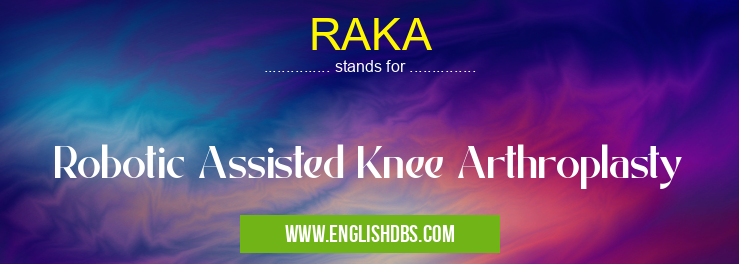What does RAKA mean in ROBOTICS
Robotic Assisted Knee Arthroplasty (RAKA) is an innovative form of orthopaedic surgery that uses the latest robotic technology to provide a highly precise, minimally invasive procedure for knee replacement. RAKA is a cutting-edge surgical technique that has revolutionized the way knee replacement procedures are performed. By using robotic surgical systems, surgeons can now achieve higher levels of accuracy and precision than what was previously possible with traditional methods. With its advanced technology, RAKA can deliver superior outcomes and drastically reduce the risk of postoperative complications.

RAKA meaning in Robotics in Academic & Science
RAKA mostly used in an acronym Robotics in Category Academic & Science that means Robotic Assisted Knee Arthroplasty
Shorthand: RAKA,
Full Form: Robotic Assisted Knee Arthroplasty
For more information of "Robotic Assisted Knee Arthroplasty", see the section below.
What does RAKA mean in science?
In science, RAKA stands for Robotic Assisted Knee Arthroplasty. This refers to the use of a robotic-assisted system in performing total or partial knee replacements. The use of robot-assisted technology increases accuracy and reduces the time needed to perform this type of procedure. It is more precise than traditional open arthoplasty surgeries and also minimizes tissue damage resulting from surgery, which leads to better patient outcomes. Additionally, it reduces hospital stays and recovery time for patients undergoing the procedure.
How does RAKA work?
RAKA utilizes advanced 3D imaging technologies such as computed tomography (CT) scans or magnetic resonance imaging (MRI) scans to create detailed models of the patient's joint anatomy before surgery begins. This allows surgeons to precisely plan their approach and select optimal implant configurations based on individual patient needs. During surgery, sensors located at various points along the robotic arm enable surgeons to make precise movements when shaping bone surfaces or implanting components with greater accuracy than could be achieved manually by a surgeon’s hand alone. By utilizing robotics technology during surgery, surgeons are able to achieve better implant positioning and improved stability over time compared with manual techniques. This ultimately results in increased longevity for total or partial knee replacements because they are placed in their ideal position from initial placement instead of having to be adjusted over time due to incorrect placement initially.
Benefits Of Robotic Assisted Knee Arthroplasty
The key benefit associated with robotic assisted knee arthroplasty is accuracy and precision that cannot be achieved with traditional open arthoplasty surgeries. Robot-assisted procedures also allow for less tissue trauma than manual techniques—a major advantage since less injury leads to faster recovery times and fewer postoperative complications or risks such as infection or stiffness later on down the line. Finally, robot-assisted joint surgery can reduce hospital stay times due to quicker recovery periods associated with minimal tissue disruption caused by robotically assisted intervention compared to manual techniques
Essential Questions and Answers on Robotic Assisted Knee Arthroplasty in "SCIENCE»ROBOTICS"
What is Robotic Assisted Knee Arthroplasty?
Robotic Assisted Knee Arthroplasty (RAKA) is a surgical procedure that uses a robotic arm to help guide the doctor and assist in the alignment of the prosthesis and joint during knee replacement surgery. It can provide a higher level of accuracy, precision, and control than traditional knee replacement techniques.
What are the benefits of RAKA?
RAKA has several potential benefits for patients who undergo knee replacement surgery. These include improved accuracy, greater precision in prosthetic placement, and improved alignment of the prosthetic components; reduced pain after surgery; shorter hospital stays; faster recovery time; improved range of motion and stability; reduced risk of complications and revision surgery; and better functional outcomes.
Is Robotic Assited Knee Arthroplasty safe?
Yes, RAKA is a safe procedure with a low risk of complications or side effects. The robotic arm provides the accurate guidance needed to ensure that your arthroplasty is performed correctly, reducing possible risks associated with manual techniques.
Is RAKA covered by health insurance?
It depends on your individual health insurance coverage plan. Some plans may cover all or part of the costs associated with RAKA while others may not cover any costs at all. Be sure to contact your insurance provider to discuss your policy coverage before having any procedure done.
How long does it take for a patient to recover from RAKA?
Recovery time will vary depending on various factors such as age, general health status prior to surgery, type of implant used, complexity of the procedure itself, etc. However, most patients can expect to regain full weight-bearing capacity within 6-8 weeks postoperatively with complete healing occurring usually within 3-4 months postoperatively.
Is there any pain associated with RAKA?
Most patients experience some degree of discomfort or pain immediately following their procedure which can vary from mild to moderate but should gradually subside over time as healing progresses and strength returns over multiple weeks/months postoperatively. Minor swelling may also be present afterwards but should also diminish with proper care over time as well.
How much does it cost for Robotic Assisted Knee Arthroplasty?
The cost for robot-assisted knee arthroplasty will vary depending on many factors including complexities involved in each specific case as determined by your physician, geographic location where surgery is being performed (in or out-of-network provider), type/manufacturer/model of implants used during procedure etc. Be sure to contact your insurance provider (if applicable) and speak directly with representatives at center providing medical services about any fees associated prior to having any surgery done.
Final Words:
Robotic Assisted Knee Arthroplasty (RAKA) is an innovative form of orthopaedic surgery that uses robots equipped with sophisticated imaging technologies and highly precise instruments for total or partial knee replacements that offer superior outcomes compared to other surgical approaches requiring much larger incisions and longer healing times postoperatively. The use of robot-assisted techniques provides high levels of accuracy while minimizing trauma during operations; leading not only to quicker recoveries but often fewer postoperative risks too such as infection or stiffness making it an ideal choice for those who need total or partial knee replacements but want minimal complications afterwards.
